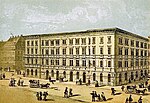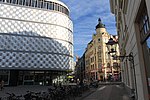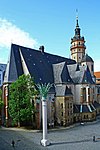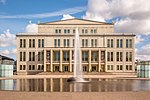Oper am Brühl

The Oper am Brühl (also Barockoper Leipzig) was the first opera house in Leipzig. It existed from 1693 to 1720 and was the second municipal music theatre in Germany, after the Oper am Gänsemarkt in Hamburg. It was initiated by Nicolaus Adam Strungk who saw a potential audience during the three annual trade fairs in Leipzig. An opera house was built, and opened on 8 May 1693. The house flourished when Georg Philipp Telemann directed the opera from 1703 to 1705. Among his operas for the house is Germanicus, premiered in 1704. A collection of 100 excerpts from the operas, Musicalische Rüstkammer, has been explored for background. The building was found in a dangerous state in 1719, was closed in 1720 and demolished in 1729.
Excerpt from the Wikipedia article Oper am Brühl (License: CC BY-SA 3.0, Authors, Images).Oper am Brühl
Ritterpassage, Leipzig Leipzig-center (Mitte)
Geographical coordinates (GPS) Address Nearby Places Show on map
Geographical coordinates (GPS)
| Latitude | Longitude |
|---|---|
| N 51.342361111111 ° | E 12.379972222222 ° |
Address
Forum am Brühl
Ritterpassage
04109 Leipzig, Leipzig-center (Mitte)
Saxony, Germany
Open on Google Maps











